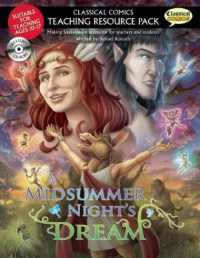Full Description
Multiliteracies: Beyond Text and the Written Word emphasizes literacies which are, or have been, common in American culture, but which tend to be ignored in more traditional discussions of literacy—specifically textual literacy. By describing multiliteracies or alternative literacies, and how they function, we have tried to develop a broader understanding of what it means to be literate in American culture. The 39 topical essays/chapters included in this work represent a sampler of both old and new literacies that are clearly at work in American culture, and which go beyond more traditional textual forms and models.
Multiliteracies: Beyond Text and the Written Word asks: How is the experience of students changing outside of traditional schools, and how do these changes potentially shape the work they do, how they learn, and the lives they lead in schools and less formal settings? This work assumes that our increasing diversity in a postmodern and increasingly global society brings with it demands for a broader understanding of what it means to be literate. Multiliteracy "literally" becomes a necessity. This work is a guidebook to the new reality, which is increasingly so important to schools and the more general culture.
Contents
Series Foreword: Landscapes of Education; William H. Schubert and Ming Fang He.
Preface: Introduction: Literacy for the 21st Century.
Chapter 1. Hypertext: An Interactive Literacy; Eugene F. Provenzo, Jr. and Amanda P. Goodwin.
Chapter 2. Facebook and Social Networking Sites: The Multiliteracy of Personal and Professional Network Building; Amanda P. Goodwin.
Chapter 3. Environmental Print; Lisa Repaskey.
Chapter 4. The City as Text; Eugene F. Provenzo, Jr.
Chapter 1. Emoticons; William B. Deese.
Chapter 5. Instant and Text Messaging; Maribel G. Harder.
Chapter 6. Numbers; Wensen Lin.
Chapter 8. Sign Languages: Communication in a Silent World; Miriam Lipsky.
Chapter 9. Tattoos: The Power of Ink; Jennifer Diptee.
Chapter 10. The Lectore: Reading Aloud as a Collective Literacy; Eugene F. Provenzo, Jr.
Chapter 1. Rap Music: A Socio-Cultural Revolution; Maribel G. Harder.
Chapter 11. Corporate Logosm; William B. Deese.
Chapter 12. AIDS Quilt as a Literacy; Lisa Repaskey.
Chapter 13. Nautical and Aeronautical Literacies; Gabriel Quintana.
Chapter 14. Scientific Simulation; Kathryn LeRoy.
Chapter 15. Streaming Messages; William B. Deese.
Chapter 16. Hmong Story Cloths; Lisa Repaskey.
Chapter 17. The Power of Puppetry; Jennifer Diptee.
Chapter 18. Death T-Shirts; Yvonne D. Perry.
Chapter 20. Roadside Memorials; Yvonne Perry.
Chapter 21. Graffiti; Lisa Repaskey.
Chapter 22. Patriotic Symbols; Gabriel Quintana.
Chapter 23. Baby Sign Language; Yvonne Perry.
Chapter 24. The Human Genome Project as Literacy; Kathryn LeRoy.
Chapter 25. Fashion Branding; Yvonne Perry.
Chapter 26. Traffic Signs; William B. Deese.
Chapter 27. Measurement Literacy; Sheree T. Sharpe.
Chapter 28. The Language of Dance; Jennifer Diptee.
Chapter 29. Interpreting Body Language: The Original Literacy; Amanda P. Goodwin.
Chapter 30. Baseball Signs: Visual Literacy at Play; Miriam Lipsky.
Chapter 31. Order of Magnitude Literacy; Sheree T. Sharpe.
Chapter 32. Becoming Literate in the Language of Dogs: A Literacy That Could Save Your Life; Miriam Lipsky.
Chapter 33. Etiquette: The Literacy of Success; Amanda P. Goodwin.
Chapter 34. Ebonics as a Literacy; Sheree T. Sharpe.
Chapter 35. Visual Representation of Mathematics; Gabriel Quintana.
Chapter 36. Medical Symbols, Shorthand, and Signage; Maribel G. Harder.
Chapter 37. Sports Literacy; Gabriel Quintana.
Chapter 38. Interpersonal Literacy through Gestures; Maribel G. Harder.
Chapter 41. Electronic Books; Eugene F. Provenzo, Jr.
Afterword.
References.








